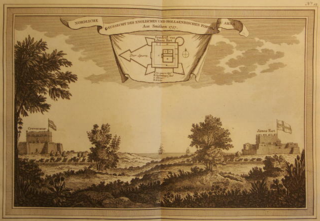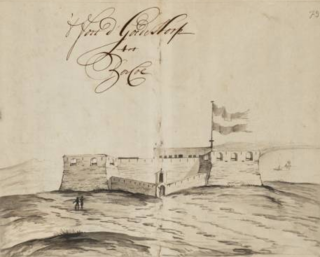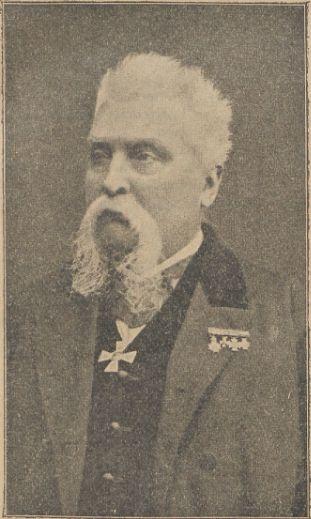
Cape Coast Castle is one of about forty "slave castles", or large commercial forts, built on the Gold Coast of West Africa by European traders. It was originally a Portuguese "feitoria" or trading post, established in 1555, which they named Cabo Corso.

The Dutch Gold Coast or Dutch Guinea, officially Dutch possessions on the Coast of Guinea was a portion of contemporary Ghana that was gradually colonized by the Dutch, beginning in 1612. The Dutch began trading in the area around 1598, joining the Portuguese which had a trading post there since the late 1400s. Eventually, the Dutch Gold Coast became the most important Dutch colony in West Africa after Fort Elmina was captured from the Portuguese in 1637, but fell into disarray after the abolition of the slave trade in the early 19th century. On 6 April 1872, the Dutch Gold Coast was, in accordance with the Anglo-Dutch Treaties of 1870–71, ceded to the United Kingdom.

The Danish Gold Coast comprised the colonies that Denmark–Norway controlled in Africa as a part of the Gold Coast, which is on the Gulf of Guinea. It was colonized by the Dano-Norwegian fleet, first under indirect rule by the Danish West India Company, later as a crown colony of the kingdom of Denmark-Norway. The area under Danish influence was over 10,000 square kilometres.

Fort Prinzenstein is a fort located at Keta, Ghana, which was used in the slave trade. Many such forts were built in Africa, but Prinzenstein is one of the few that lie east of the Volta River. Keta served as an open port until the Tema Harbour commenced its operation to the west in 1962. The fort has been designated a World Heritage Site because of its historical importance and testimony to the Atlantic slave trade.

Osu Castle is a castle located in Osu, Ghana, on the coast of the Gulf of Guinea in Africa.

The Treaty of Butre between the Netherlands and Ahanta was signed at Butre, Dutch Gold Coast on 27 August 1656. The treaty regulated the jurisdiction of the Netherlands and the Dutch West India Company over the town of Butre and the surrounding country of Upper Ahanta, creating a Dutch protectorate over the area, and permitting the establishment of Fort Batenstein. The treaty lasted until the Dutch departure from the Gold Coast in April 1872.

Fort Patience is a Dutch-built fort located in the township of Apam, in the Central Region of Ghana. Originally built in 1697, it served as a defensive fortification and a trading post. Because of its testimony to European pre-colonial and colonial influence in West Africa, the fort was inscribed on the UNESCO World Heritage List along with several other forts and castles in Ghana.

Fort Saint Anthony was a fort built by the Portuguese in 1515 near the town of Axim, in what is now Ghana. In 1642, the Dutch captured the fort and subsequently made it part of the Dutch Gold Coast. The Dutch expanded the fort considerably before they turned it over, with the rest of their colony, to the British in 1872. The fort is now the property of the Ghanaian state and is open to the public.

Ussher Fort is a fort in Accra, Ghana. It was built by the Dutch in 1649 as Fort Crèvecœur, and is two days' march from Elmina and to the east of Accra on a rocky point between two lagoons. It was one of three forts that Europeans built in the region during the middle of the 17th century. Fort Crèvecœur was part of the Dutch Gold Coast. The Anglo-Dutch Gold Coast Treaty (1867), which defined areas of influence on the Gold Coast, transferred it to the British in 1868. Because of its significance in the history of European colonial trade and exploitation in Africa, the fort was inscribed on the UNESCO World Heritage List in 1979.

Fort Amsterdam is a former slave fort in Abandze, Central region, Ghana. It was built by the English between 1638 and 1645 as Fort Cormantin or Fort Courmantyne, and was captured by admiral Michiel de Ruyter of the Dutch West India Company in 1665, in retaliation for the capture of several Dutch forts by the English Admiral Holmes in 1664. It was subsequently made part of the Dutch Gold Coast, and remained part of it until the fort was traded with the British in 1868. The Fort is located at Abandze, on the north-east of Cape Coast in the Mfantseman District of the Central Region of Ghana. Because of its testimony to European economic and colonial influence in West Africa and its historical importance in the Atlantic slave trade, the fort was inscribed on the UNESCO World Heritage List in 1979 along with other forts and castles in Ghana.

Fort Batenstein was a fort and trading post established by the Dutch on the Gold Coast in 1656. It was situated near Butre. The fort was ceded with the entire Dutch Gold Coast to Britain in 1872.

Fort Vredenburgh was a Dutch fort on the Gold Coast, established on the left bank of the Komenda River. The fort exists as preserved ruins. Because of its testimony to European economic and colonial influence in West Africa, the fort was inscribed on the UNESCO World Heritage List in 1979, along with other nearby forts and castles.

Fort de Goede Hoop or Fort Good Hope was a fort on the Dutch Gold Coast, established in 1667 near Senya Beraku.

Fort William is a fort in Anomabu, Central Region, Ghana, originally known as Fort Anomabo and renamed Fort William in the 1830s by its then-commander, Brodie Cruickshank, who added one storey to the main building, and renamed the fort after King William IV.

Fort James is a fort located in Accra, Ghana. It was built by the Royal African Company of England (RAC) as a trading post for both gold and slaves in 1673, where it joined the Dutch Fort Crêvecœur (1649), and the Danish Fort Christiansborg (1652) along the coast of the then Gold Coast. Along with other castles and forts in Ghana, Fort James was inscribed on the UNESCO World Heritage List in 1979 because of its importance during the European colonial period.

Cornelis Johannes Marius Nagtglas was a Dutch politician and civil servant, who made a career in the administration on the Dutch Gold Coast. After originally beginning his career at the advanced age of 36, he was promoted through the ranks to eventually become Governor of the Dutch Gold Coast in 1858. He retired to the Netherlands in 1862, but returned to the Gold Coast as governor in 1869, to restore order in the embattled colony. In 1871, he left the Gold Coast again, one year before the transfer of the colony to the United Kingdom.
Albert van Dantzig was a Dutch historian of the Dutch colonization of the Gold Coast. From 1963 until his retirement, he served as Professor of History at the University of Ghana at Legon.

Fort William Lighthouse is located on the Dawson's Hill in the old centre of Cape Coast, in Ghana's Central Region. The lighthouse is often called Cape Coast Castle Light, although it is not part of the Cape Coast Castle complex. It is about 600 metres away from the Castle. Along with the Cape Coast Castle and other castles and forts in Ghana, the lighthouse was inscribed on the UNESCO World Heritage List in 1979 because of its historical importance.

The Dano-Dutch War was a colonial conflict between the Danes and Dutch over the control of European fortifications on the Gold Coast. Denmark-Norway, assisted by England, defeated the Dutch in various places, although Michiel de Ruyter retaliated against the English by recapturing all forts but Cape Coast. This forced the Royal African Company into bankruptcy, which started the Second Anglo-Dutch War.


















